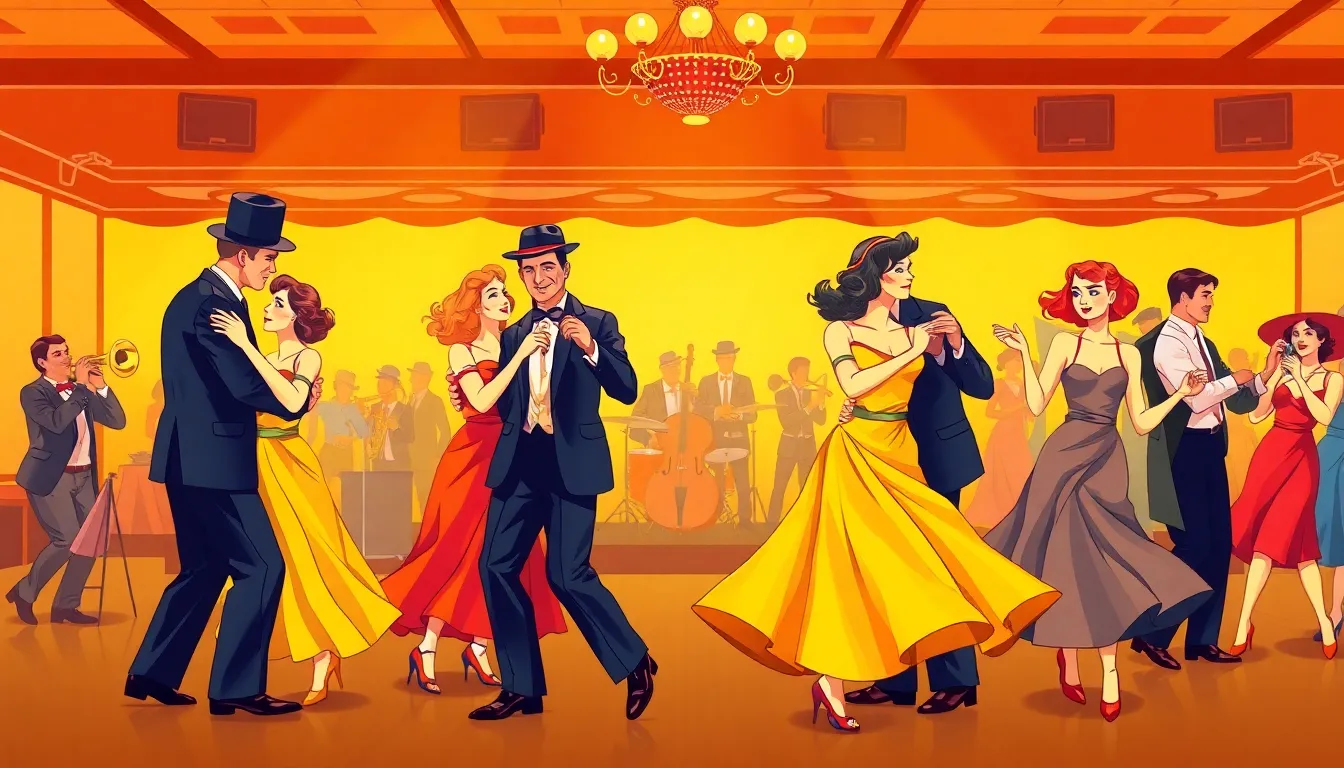Table of Contents
ToggleThe 1940s were a whirlwind of change, creativity, and a dash of chaos that shaped the very fabric of pop culture as we know it today. As the world grappled with the aftermath of war, music, film, and fashion took center stage, offering a much-needed escape and a sense of hope. From the swing of jazz to the glitz of Hollywood, this decade packed a punch that still resonates.
Overview of 1940s Pop Culture
The 1940s were pivotal in shaping modern pop culture, characterized by developments in music, film, and fashion. Music, especially jazz, experienced a surge in popularity, offering a vibrant escape. Big bands and swing music dominated the airwaves, captivating audiences across the nation.
Film became a powerful medium during this decade, with Hollywood producing iconic classics. Movies like “Casablanca” and “Gone with the Wind” not only entertained but also provided comfort amid global conflicts. The film industry thrived, with movie stars such as Humphrey Bogart and Ingrid Bergman becoming household names.
Fashion reflected an era of innovation, with styles influenced by wartime practicality and post-war optimism. Women embraced more versatile clothing, often adopting styles like the “New Look” which emphasized a feminine silhouette. Men’s fashion, too, evolved, showcasing tailored suits and military-inspired looks.
Television began to emerge as a new form of entertainment towards the end of the decade. Families gathered around black-and-white television sets to enjoy early shows and sporting events, paving the way for future broadcasting.
The influence of the 1940s endures in contemporary culture, as modern artists and creators draw inspiration from this transformative period. The decade’s cultural legacy underscores how art and entertainment can offer solace and connection in difficult times.
Major Trends in the 1940s

The 1940s witnessed remarkable trends that shaped popular culture during a time of upheaval. Music, film, and fashion reflected the era’s dynamism and resilience.
Music and Dance
Big band music thrived in the 1940s, showcasing the talents of artists like Duke Ellington and Benny Goodman. Swing dance became immensely popular, attracting crowds to dance halls across America. Dance marathons provided a unique form of entertainment, featuring couples competing for endurance and prizes. Jazz expanded its reach, introducing rhythm and improvisation that inspired new genres. Vocalists like Ella Fitzgerald gained prominence, elevating the standards of performance art. A blend of upbeat swing and poignant ballads allowed audiences to find solace amid the uncertainties of war, reinforcing music’s enduring role in shaping cultural landscapes.
Film and Cinema
Cinema flourished as an escape from the harsh realities of World War II. Iconic films such as “Casablanca” offered memorable performances and compelling narratives that resonated with audiences. The emergence of Technicolor transformed visual storytelling, enhancing the movie-watching experience. Film noir gained traction, characterized by its dark themes and morally ambiguous characters. Stars like Humphrey Bogart and Ingrid Bergman became household names, solidifying Hollywood’s glamour in public imagination. This decade laid the groundwork for modern filmmaking, influencing future genres and cinematic techniques.
Fashion in the 1940s
Fashion in the 1940s epitomized a unique blend of resilience against adversity and a quest for elegance. The styles reflected the social and cultural shifts of the decade.
Iconic Styles
Iconic styles showcased the influence of both wartime practicality and glamorous post-war desires. Women favored the “New Look” introduced by Christian Dior in 1947, characterized by full skirts and defined waists, emphasizing femininity. Tailored suits became a staple for men, featuring broad shoulders and structured silhouettes, demonstrating a stylish yet sturdy approach. Accessories like hats and gloves added sophistication to women’s outfits. Meanwhile, fabrics such as rayon were preferred due to wartime restrictions on materials. These trends not only offered a sense of normalcy but also allowed individuals to express creativity amidst challenging circumstances.
Influences of War on Fashion
The influences of war significantly shaped fashion choices during the 1940s. Rationing led to limited fabric availability, prompting designers to focus on simpler, more functional styles. Utility clothing became popular, prioritizing comfort and durability over extravagance. Women entered the workforce, igniting a demand for practical yet fashionable attire such as trousers and workwear, which challenged traditional gender roles. The transition from wartime to peacetime brought about a renewed sense of optimism, resulting in more lavish, expressive designs as the decade progressed. Fashion mirrored societal changes, embodying both the hardships of the era and the aspirations of a more hopeful future.
Literature and Comics
The 1940s showcased significant developments in literature and comics, reflecting societal changes and cultural trends.
Prominent Authors and Works
Authors like John Steinbeck and Kurt Vonnegut emerged during this decade. Steinbeck’s “The Grapes of Wrath” continued to resonate, offering deep social commentary on hardship. Vonnegut’s “Player Piano,” published in 1952, explored dystopian themes that began shaping literary conversations. Additionally, Zora Neale Hurston’s “Their Eyes Were Watching God” became a pivotal work, celebrating African American women’s voices. Poetry flourished too, with figures like Langston Hughes using verse to address social justice. Throughout the decade, literature served as a powerful medium for reflection on contemporary issues.
The Rise of Comic Books
Comic books became a popular form of entertainment in the 1940s. Titles like “Superman” and “Batman” debuted, creating cultural icons and a new genre. This period marked the expansion of superheroes, reflecting societal hopes and fears during wartime. Characters embodied ideals of bravery and justice, capturing the imagination of young readers. Additionally, publishers like Marvel and DC played crucial roles in the comic book boom. By the end of the decade, comics gained mainstream recognition, leading to a lasting legacy in pop culture.
The Role of Radio and Television
Radio played a crucial role in shaping the pop culture of the 1940s. It served as the primary source of entertainment and news, connecting families through broadcasts of music, drama, and live events. Programs featuring big band music attracted wide audiences, while shows like “Your Hit Parade” showcased popular songs, influencing music trends.
Television began its ascent during this decade. Although its reach remained limited, early broadcasts introduced viewers to new shows, laying the foundation for future programming. Key events, such as the 1948 presidential election, highlighted television’s potential influence on public perception.
While radio offered an escape through sensory stimulation, television added a visual dimension. Audiences could now enjoy glamorous Hollywood stars on their screens. Many households owned radios, turning them into communal hubs for listening and sharing experiences.
Listeners frequently tuned into news bulletins during wartime, receiving updates on military events and progress. Such information was vital, connecting communities through shared narratives. Airwaves buzzed with hope and entertainment, helping people cope with uncertainties surrounding the war.
With the rise of radio dramas, storytelling evolved, capturing listener imaginations. Popular programs created characters who embodied social values and moral lessons, enriching cultural dialogue. The combination of music, narrative, and news transformed how people engaged with the world around them.
The 1940s marked the beginning of a new entertainment era, paving the way for the television boom in subsequent decades. Cultural shifts initiated during this period laid the groundwork for the diverse media landscape seen today.
The 1940s stand as a cornerstone in the evolution of pop culture. This decade not only shaped music and film but also transformed fashion and literature, reflecting the resilience and aspirations of society during challenging times. The emergence of jazz, the rise of Hollywood glamour, and the birth of iconic superheroes showcased a blend of hope and escapism.
As radio and television began to intertwine with daily life, they created new avenues for entertainment and connection. The cultural shifts of this era continue to resonate today, reminding us of the power of art to uplift and inspire. The legacy of the 1940s remains a testament to creativity’s ability to thrive amidst adversity.







